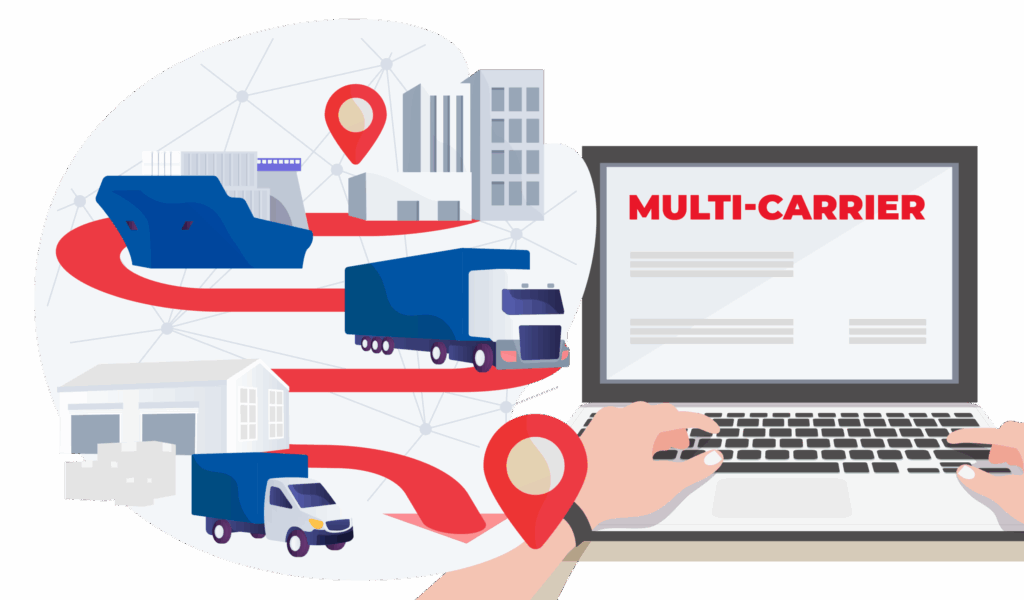Ecommerce Shipping Integration: 5 Smart Ways to Cut Costs and Win Customer Trust
Shipping costs are a constant challenge for online businesses. Each order shipped reduces margins, and every mistake in fulfillment can damage customer trust. Ecommerce Shipping Integration offers a solution by connecting your store, carriers, and warehouse in one streamlined system. This setup not only reduces costs but also creates a smoother, more reliable experience for your customers.

Why Is Ecommerce Shipping Integration the Key to Lowering Costs?
When shipping is managed manually, businesses face high carrier fees, slow workflows, and frequent errors. Integration changes this by providing:
- Real-time tracking of every shipment: Sellers and customers can see where a package is at any moment, reducing uncertainty and support requests.
- Access to multiple carriers and their live rates: The system compares options instantly, ensuring each order uses the most cost-effective and reliable service.
- Automated label creation and batch processing: Labels are generated directly from order data, cutting manual work and speeding up large-volume fulfillment.
- Reliable data for negotiations and decision-making: Detailed shipping reports reveal costs and volumes, giving businesses leverage to secure better carrier rates.
These advantages help sellers reduce costs while improving the delivery experience for customers.
1. How Can Multi-Carrier Access Drive Down Fees?
The Problem: Limited Choices Increase Costs
Depending on one carrier often means paying fixed rates and having no backup when issues arise.
The Integration Advantage
Ecommerce Shipping Integration allows businesses to connect with multiple carriers at the same time. The system compares rates and automatically selects the most efficient option for each order.

Key Benefits
- Real-time rate comparison across carriers → Businesses can always select the cheapest option for each delivery, reducing unnecessary costs.
- Flexible switching if one carrier faces delays → Ensures deliveries stay on track and customers don’t suffer from slowdowns.
- Better regional coverage at lower costs → Local couriers can be used when cheaper, while national carriers handle wider coverage efficiently.
2. How Does Automated Labeling Save Time and Money?
The Problem: Manual Errors Create Extra Costs
Typing addresses and package details by hand often leads to mistakes. Wrong entries cause surcharges, returns, and wasted labor.
The Integration Advantage
Ecommerce Shipping Integration pulls data directly from orders, removing manual steps. Batch printing and address validation speed up processing and cut costly errors.
Key Benefits
- Lower labor costs through batch processing → Staff can print labels for dozens of orders at once, saving time and salaries.
- Fewer address correction fees → Labels pull accurate customer data automatically, cutting expensive error charges.
- Faster warehouse operations during busy seasons → Workers move smoothly without bottlenecks caused by paperwork.
3. Can Smart Routing and Zone Skipping Reduce Long-Distance Costs?
The Problem: Paying for Multiple Zone Crossings
Carriers increase fees when shipments cross several zones, making long-distance delivery more expensive.
The Integration Advantage
With Ecommerce Shipping Integration, businesses can group packages together and send them in bulk to regional hubs. From there, deliveries are handled locally, skipping unnecessary zones.

Key Benefits
- Lower long-distance shipping fees → Bulk shipping reduces the number of zones crossed, directly cutting carrier charges.
- Faster deliveries to customers → Packages arrive sooner when sent to nearby hubs before final delivery.
- Opportunity to offer free-shipping thresholds → Savings allow sellers to set attractive free-shipping incentives that raise order value.
4. What Role Do Negotiated Carrier Rates Play?
The Problem: Paying Standard Retail Rates
Without data, businesses often miss opportunities to negotiate better deals with carriers.
The Integration Advantage
Integration platforms generate accurate reports on total shipping volume. Sellers can use this information to negotiate more favorable rates.
Key Benefits
- Up to 20% savings from volume-based discounts → Integration data proves shipping volume, giving leverage for discounts.
- Automatic application of negotiated rates → The system applies your contract terms at checkout without manual input.
- Easier monitoring of contract terms → Reports show if carriers are honoring agreed discounts, preventing hidden overcharges.
5. How Do Real-Time Rates Prevent Overpaying and Cart Abandonment?
The Problem: Flat Rates Create Friction
Flat-rate shipping can either reduce profit margins or cause customers to abandon their carts due to high costs.

The Integration Advantage
Checkout pages connected through integration display live carrier rates, ensuring transparency for both sides.
Key Benefits
- Reduced cart abandonment caused by hidden costs → Customers see exact fees upfront, avoiding last-minute surprises.
- Protected margins through accurate pricing → Businesses avoid losing money by undercharging or overcharging for shipping.
- Greater transparency that builds customer trust → Buyers appreciate honest, real-time costs, making them more likely to return.
Bonus: Can AI-Driven Shipping Predictions Add Extra Value?
Some modern shipping platforms now include AI tools that predict delays, suggest better carriers, and reroute shipments automatically. By identifying risks early, businesses reduce failed deliveries, refunds, and customer complaints. AI-driven shipping is still developing, but early adopters are already gaining a competitive edge.
Frequently Asked Questions (FAQ)

What is Ecommerce Shipping Integration?
It is the process of connecting your online store, carriers, and warehouse systems into one platform. This allows automation of shipping tasks such as label printing, carrier selection, and tracking updates.
How does integration reduce shipping costs?
By giving access to multiple carriers, comparing live rates, and applying negotiated discounts, integration ensures businesses never overpay for shipping services.
Can small businesses benefit from shipping integration?
Yes. Even small sellers can save money by using real-time rates and automated labels. Integration also helps them negotiate better deals as shipping volumes grow.
Does integration improve customer satisfaction?
Absolutely. Customers see accurate rates at checkout, receive timely updates, and enjoy faster deliveries. Transparency and reliability increase trust and encourage repeat purchases.
Is AI in shipping integration worth using now?
While still developing, AI-powered tools can predict delays and suggest better routes. Early adopters often gain an advantage by avoiding costly problems before they happen.
Conclusion
Cutting shipping costs does not require lowering service quality. By adopting Ecommerce Shipping Integration, businesses can:
- Access multiple carriers for lower rates
- Automate labeling to cut errors and labor costs
- Use smart routing and zone skipping to save on long-distance shipping
- Negotiate better deals with carriers using data
- Display real-time rates to protect margins and reduce abandoned carts
These five strategies create a more efficient and scalable system, helping businesses save money while improving customer loyalty.
For sellers ready to simplify shipping and reduce costs, Postalparcel provides integration tools designed to support growth. Learn more at Postalparcel.
Industry Insights
news via inbox
Nulla turp dis cursus. Integer liberos euismod pretium faucibua







